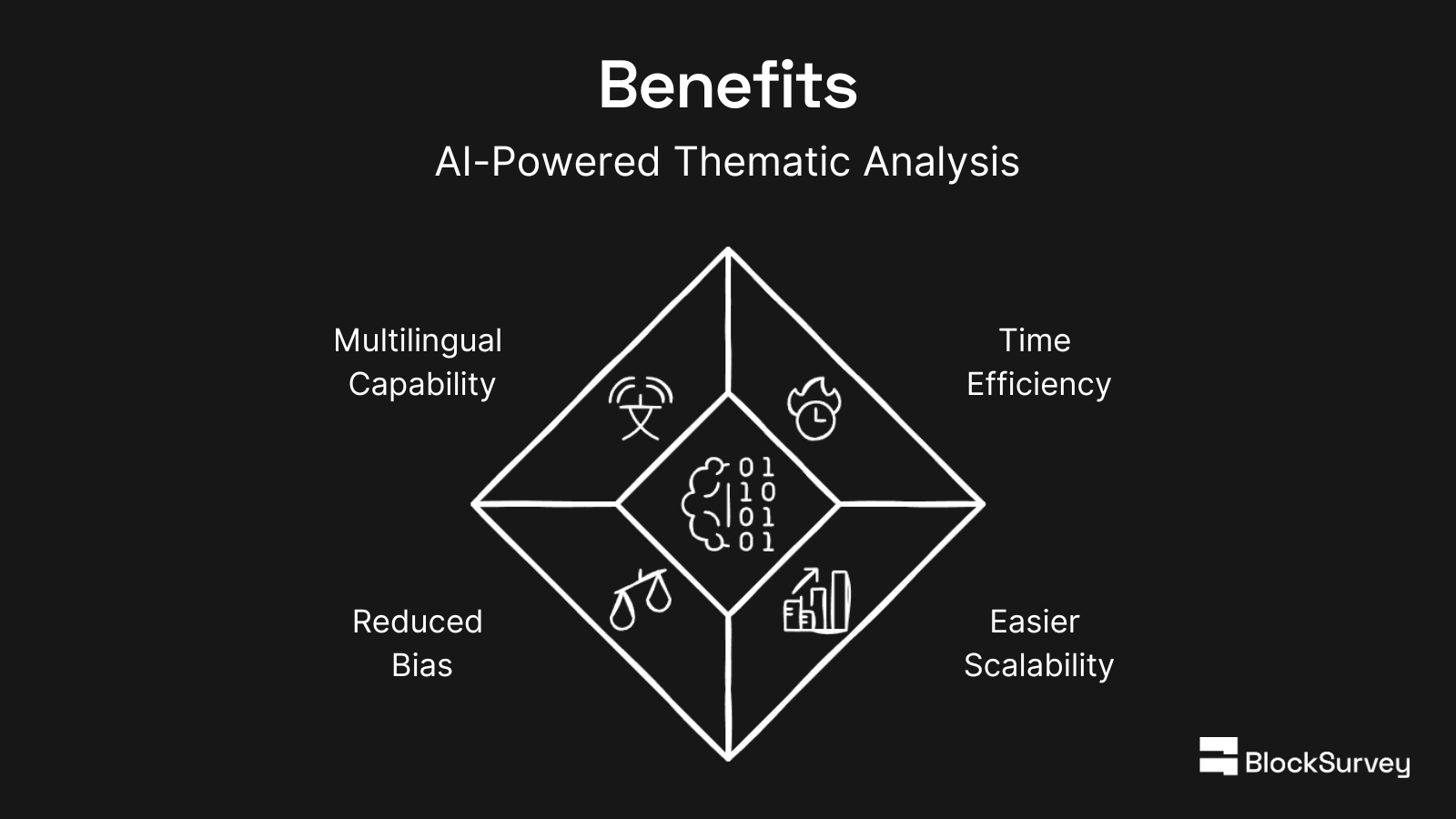Get insights.
Unlock value.
- 14-day free trial
- Set up in minutes
- No credit card required
Is AI-Powered Thematic Analysis Transforming Qualitative Research?
If you are a researcher, you definitely must have experienced spending long hours doing your analysis. Especially while doing Thematic analysis, generating common themes from survey responses, interview transcripts, or any other source can be time-consuming.
Have you ever thought of using an AI-powered Thematic analysis tool? Do you doubt if AI tools can help you perform Thematic analysis better? Are you worried that AI tools can decrease the quality of research? No more confusion. In this blog, I will comprehensively discuss AI-powered Thematic Analysis.
When you finish reading this blog, you can discern whether AI-powered Thematic Analysis can truly transform your qualitative research process.
Although using AI has a plethora of benefits, I must accept it has its limitations, too. Let me start discussing limitations first. Read on.
What are the Limitations of AI-Powered Thematic Analysis?
Requires Human Oversight: AI-powered Thematic Analysis can speed up the process, especially when dealing with large datasets. However, human supervision is required to ensure the accuracy & clarity of the findings.
Slight Learning Curve: For those researchers who are used to performing Thematic Analysis manually, there will be a learning curve when they first start using AI-powered tools. However, they will gain control through practice.
It’s time to look into the benefits.
What are the Benefits of AI-Powered Thematic Analysis?

Time Efficiency: Your time spent performing Thematic Analysis can be greatly reduced. You no longer have to feel the pain of strenuous hours spent, with manual Thematic Analysis. However, ensure human supervision for accuracy in findings.
Easier Scalability: It can be convenient to analyze 10 lines of data for common themes & patterns. What if you are asked to analyze 1 lakh lines of data? AI-Powered Thematic Analysis can be the perfect aid at those times. AI tools are known for Scalability.
Reduced bias: Bias may arise out of human intervention while performing manual Thematic analysis. This bias is controlled when using an AI-powered tool for your analysis. Reduced bias in the results.
Multilingual: The multilingual nature of AI is a defining benefit. You can perform thematic analysis on transcripts of any language. You can also translate the output to a language of your choice for making decisions.
In the following case study, find out how AI Thematic Analysis allows for nuanced findings.
Case Study: Identifying Nuances In Customer Experience With AI
Let’s say you are researching customer experience for a lodging hotel. You perform AI Thematic Analysis on the customer feedback and end up with the themes below.
- Staff Friendliness
- Room Cleanliness
- Value For Money
The various stages of your experience with the hotel are listed below.
- Check-in
- During Stay
- Check-out
AI has this innate ability to relate the identified themes with the stages. For example, AI can detect experiences from the theme “Staff Friendliness” spanning different stages.
- Check-in - “Warm Welcome at reception”
- During Stay - “Polite Maintenance Staff”
- Check-out - “Pleasant Departure Experience”
Such nuanced temporal analysis is possible with AI-assisted Thematic Analysis. Manual Thematic Analysis may not identify such temporal nuances. Even if it captures such nuances, it can be time-consuming. BlockSurvey can help you capture such nuanced patterns with the help of AI Thematic Analysis.
Methods to Boost AI Thematic Analysis
I can think of the below 2 proven methods to boost the quality of your AI Thematic Analysis.
Iterative Refinement: You can ask the AI to refine your analysis 3 or 4 times. You can provide your feedback on each analysis that can be incorporated into the next iteration. This interactive refinement can further enhance & boost the quality of your thematic analysis and help you make better decisions.
Cross Validation: As an additional measure, you can perform Thematic Analysis with multiple AI tools and cross-validate your findings. This will help you thwart biases that belong to any particular AI System.
Let’s see what’s ahead with AI-powered Thematic Analysis.
What’s Ahead
It is understood that AI-powered analysis requires a balance between human supervision & AI capability. This balance leads to better outcomes, truly transforming your Thematic Analysis process.
It is worth noting that many AI-powered tools like BlockSurvey, NVivo, and MAXQDA are available. This blog is from BlockSurvey, a privacy-focused, AI-driven data collection tool apt for Thematic Analysis.
Why not try BlockSurvey for your data collection & AI Thematic analysis?
Is AI-Powered Thematic Analysis Transforming Qualitative Research? FAQ
What kind of data can be used with AI-powered thematic analysis?
AI-powered thematic analysis can be used with various types of qualitative data, including Interview transcripts, Focus group discussions, Survey responses, Social media posts, Customer reviews, News articles, & Open-ended responses from questionnaires.
How do AI-powered thematic analysis tools handle the nuances of language, such as sarcasm or figurative language?
AI-powered thematic analysis tools are still under development when it comes to understanding complex nuances of language like sarcasm or metaphors. While they can identify patterns in text, they may not always accurately interpret the intended meaning, especially in cases of figurative language. Human oversight is crucial in reviewing and refining the AI's analysis to ensure accurate interpretation.
Can AI-powered thematic analysis completely replace human researchers?
No. AI-powered thematic analysis tools are meant to assist and augment human researchers, not replace them. While these tools offer benefits like time efficiency and scalability, human expertise is still essential for tasks such Formulating research questions, Designing the study, Interpreting the findings in context, & Ensuring ethical considerations are met.
How can I choose the right AI-powered thematic analysis tool for my research needs?
Consider the following factors when choosing an AI-powered thematic analysis tool. -Specific research needs: Determine the type of data you'll be analyzing and the desired outcomes. -Features offered: Compare features such as data visualization, sentiment analysis, and language support. -Ease of use: Opt for user-friendly interfaces and intuitive workflows. -Cost: Evaluate pricing models and consider your budget. -Data security and privacy: Choose tools that prioritize the security and privacy of your data. -Integration with other tools: Consider if the tool integrates with other software you use for research, such as survey platforms or data analysis tools. -It's helpful to read reviews, compare different tools, and try out free trials before making a decision.
Get insights.
Unlock value.
- 14-day free trial
- Set up in minutes
- No credit card required

